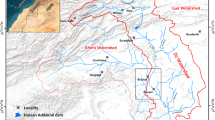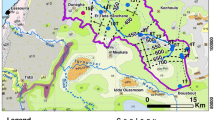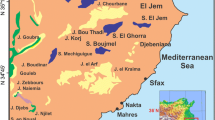Abstract
In the Grombalia region, Cap Bon Peninsula, northeastern Tunisia, increasing population and development of agricultural activity during the last few decades have engendered large expansion of groundwater pumping from the shallow, unconfined aquifer. Recently, the water table has displayed some signs of overexploitation such as decline in the water level in boreholes and considerable deterioration of water quality. Hydrochemical and isotopic data were used in conjunction with hydrogeological characteristics to investigate the groundwater composition in this aquifer. It has been demonstrated that groundwaters, recharged mainly in the surrounding foothills, acquire their mineralization principally by water–rock interaction, i.e., dissolution of evaporites and reverse cation exchange, and secondarily by return flow of irrigation waters. The isotopic signature of groundwaters permits identification of two different types. Water with depleted δ18O and δ2H contents is interpreted as recharge by non-evaporated rainfall, originating from a mixture of Atlantic and Mediterranean air masses. However, water with relatively enriched δ18O and δ2H contents is thought to reflect contamination by return flow of irrigation waters. Tritium contents, ranging between 1.2 and 4.5 TU indicate that groundwaters in an unconfined aquifer derive from post-nuclear recharge or contain a significant component of post-1950s water. The recent origin of these groundwaters is confirmed by the high carbon-14 activities, exceeding sometimes 100%, indicating the existence of a significant fraction of organic 14C. This younger source of radiocarbon is, however, highlighted by the depleted δ13C contents, corresponding to a system where CO2 of C4 plants predominates.





















Similar content being viewed by others
References
Adams S, Tredoux G, Harris C, Titus R, Pietersen K (2001) Hydrochemical characteristics of aquifers near Sutherland in the Western Karoo, South Africa. J Hydrol 241:91–103
Allison GB (1982) The relationship between 18O and deuterium in water and in sand columns undergoing evaporation. J Hydrol 76:1–25
Ball JW, Nordstrom DK (1991) WATEQ4F—user’s manual with revised thermodynamic database and test cases for calculating speciation of major, trace and redox elements in natural waters. United States Geological Survey, Open-File Report, 90–129 pp
Banner JL, Wasserburg GJ, Dobson PF, Carpenter AB, Moore CH (1989) Isotopic and trace-element constraints on the origin and evolution of saline groundwaters from central Missouri. Geochim Cosmochim Acta 53:383–398
Ben Ayed N (1993) Évolution tectonique de l’avant-pays de la chaîne alpine de la Tunisie du début du Mésozoïque à l’Actuel. Thèse d’État Université de Paris-11, Orsay
Ben Moussa A (2007) Caractérisation hydrogéologique hydrochimique et isotopique de nappe phréatique de Grombalia, Master, Université de Sfax, Tunisie
Ben Salem H (1995) Évolution de la péninsule du cap Bon (Tunisie orientale) au cours du Néogène, Notes Service Géologique. Tunisie 61:73–84
Blondel JAT (1991) Les séries à tendance transgressive marine du Miocène inférieur à moyen de la Tunisie centrale [Trangressive series of the Lower and middle Miocene in central Tunisia]. PhD Thesis, University of Genova, Italy
Brondi M, Fidelibus MD, Gragnani R, Tulipano L (1983) Hydrochemical study and distribution of some trace elements in the most important coastal springs and groundwater of the Apulian region (southern Italy). Geologia Applicatta et Idrogeologia 17(2):65–80
Burdon DJ, Malzoum J (1958) Some chemical types of groundwater from Syria. In: Proceedings of the UNESCO Symposium, Teheran. UNESCO, Paris, 73–90 pp
Burollet PF (1956) Contribution à l’étude stratigraphique de la Tunisie centrale. Annale des mines et de la géologie, 345 p
Celle H (2000) Caractérisation des précipitations sur le pourtour de la méditerranée occidentale. Approche isotopique et chimique. [Rainfall characterisation on the western Mediterranean rim: an isotopic and chemical approach]. PhD Thesis, Université d’Avignon et Pays-de-Vaucluse
Celle-Jeanton H, Travi Y, Blavoux B (2001) Isotopic typology of the precipitation in the western Mediterranean region at three different time scales. Geophys Res Lett 28(7):1215–1218
Chaieb M, Boukhriss M (1998) Flore suscinte et illustrée des zones arides et sahariennes de Tunisie. APNES, Tunis, p 29
Chihi L (1995) Les fossés néogènes à quaternaires de la Tunisie et de la mer Pélagienne : une étude structurale et une signification dans le cadre géodynamique de la Méditerranée centrale. Thèse d’État, Université de Tunis II
Clark I, Fritz P (1997) Environmental isotopes in hydrogeology. Lewis Publishers, Boca Raton
Coleman ML, Shepherd TJ, Durham JJ, Rouse JE, Moore GR (1982) Reduction of water with zinc for hydrogen isotope analysis. Anal Chem 54:993–995
Colleuil B (1976) Etude stratigraphique et néotectonique des formations néogènes et quaternaires de la région de Hammamet-Nabeul (Cap Bon) D.E.S, Université de Nice
Craig H (1961) Isotopic variations in meteoric waters. Science 133:1702–1803
Dansgaard W (1964) Stable isotopes in precipitation. Tellus 16:436–438
Dassi L (2004) Etude hydrogéologique, géochimique et isotopique du système aquifère du bassin de Sbeïtla (Tunisie Centrale). Thèse, University Sfax, Tunisie, 180 p
Dassi L (2009) Use of chloride mass balance and tritium data for estimation of groundwater recharge and renewal rate in an unconfined aquifer from North Africa: a case study from Tunisia Environmental Earth Sciences. doi:10.1007/s12665-009-0223-1
DGRE (Direction Générale des Ressources en Eau) (1990) Annuaire piézométrique de la Tunisie. DGRE, Tunis, Tunisie
DGRE (Direction Générale des Ressources en Eau) (2005) Annuaire de l’exploitation des nappes phréatique de la Tunisie. DGRE, Tunis, Tunisie
Edmunds WM, Smedley PL (2000) Residence time indicators in groundwater: the East Midlands Triassic sandstone aquifer. Appl Geochem 15:737–752
Elmejdoub N, Jedoui Y (2009) Pleistocene raised marine deposits of the Cap Bon Peninsula (N–E Tunisia): Records of sea-level highstands, climatic changes and coastal uplift. Geomorph 112:179–189
Epstein S, Meyada TK (1953) Variations of 18O content of waters from natural sources. Geochim Cosmochim Acta 4:213–224
Faye S, Maloszewskib P, Stichlerb W, Trimbornb P, Fayea SC, ChB Gaye (2005) Groundwater salinization in the Saloum (Senegal) delta aquifer: minor elements and isotopic indicators. Sci Total Environ 343:243–259
Fontes JCh (1976) Isotopes du milieu dans les eaux naturelles. La Houille Blanche 314:205–221
Garcia MG, Del Hidalgo M, Blesa MA (2001) Geochemistry of groundwater in the alluvial plain of Tucuman province. Argent Hydrogeol J 9:597–610
Gat JR, Matusi E (1991) Atmospheric water balance in the Amazon Basin: an isotopic evapotranspiration model. J Geophys Res 96:13179–13188
Gi-Tak C, Kangjoo K, Seong T, Kyoung H, Soon O, Byoung Y, Hyoung S, Chul W (2004) Hydrogeochemistry of alluvial groundwaters in an agricultural area: an implication for groundwater contamination susceptibility. Chemosphere 55:369–378
Gosselin DC, Harvey FE, Frost C, Stotler R, Macfarlane PA (2004) Strontium isotope geochemistry of groundwater in the central part of Dakota (Great Plains) aquifer, USA. Appl Geochem 19:359–377
Hadj Sassi M, Zouari H, Jallouli C (2006) Contribution de la gravimétrie et de la sismique réflexion pour une nouvelle interprètation géodynamique des fossés d’effondrement en Tunisie: exemple du fossé de Grombalia. Compt Rend Géosc 338:751–756
Hamed Y, Dassi L, Ahmadi R, Ben Dhia H (2008) Geochemical and isotopic study of the multilayer aquifer system in the Moulares-Redayef basin, southern Tunisia. J Hydrol Sci 53(C5):1241–1252
Hem JD (1989) Study and interpretation of the chemical characteristics of natural water, 3rd edn. US Geological Survey, Water-Supply Paper, 2254:89
IAEA/WMO (1999) Global network for isotopes in precipitation. The GNIP Database, Release 3. http://www.iaea.org/programs/ri/gnip/gnipmain.htm
Kamel S, Dassi L, Zouari K, Abidi B (2005) Geochemical and isotopic investigation of the aquifer system in the Djerid-Nefzaoua basin, southern Tunisia. Environ Geol 49:159–170
Lucas LL, Unterweger MP (2000) Comprehensive review and critical evaluation of the half-life of tritium. J Res Natl Inst Stand Technol 105(4):541–549
Machavaram MV, Krishnamurthy RV (1995) Earth surface evaporative process: a case study from the Great Lakes region of the United States based on deuterium excess in precipitation. Geochim Cosmochim Acta 59:4279–4283
Mahjoub O, Leclercq M, Bachelot M, Casellas C, Escand A, Balaguer P, Bahri A, Gomez E, Fenet H (2009) Estrogen, aryl hydrocarbon and pregnane X receptors activities in reclaimed water and irrigated sols in Oued Souhil area (Nabeul, Tunisia). Desalinisation 246:425–434
Maliki MA, Krimissa M, Michelot JL, Zouari K (2000) Relation entre nappes superficielles et aquifère profond dans le bassin de Sfax, Tunisie [Relation between the superficial aquifers and the deep aquifer of the Sfax basin, Tunisia]. Compte Rendus de l’Académie des Sciences 331:1–6
Mann AW (1983) Hydrogeochemistry and weathering on the Yilgarn Block, Western Australia—ferrolysis and heavy metals in continental brines. Geochim Cosmochim Acta 47:181–190
Marfiaa AM, Krishnamurthya RV, Atekwanab EA, Pantonc WF (2004) Isotopic and geochemical evolution of ground and surface waters in a karst dominated geological setting: a case study from Belize, Central America. Appl Geochem 19:937–946
Mc Lean W, Jankowski J, Lavitt N (2000) Groundwater quality and sustainability in alluvial aquifer, Australia. In Sililoo. Et (eds) Groundwater, past achievement and future challenges. Bolkema, Rotterdamm, 567–573 pp
Melanie JL, Marshall JD (2004) Palaeoclimate interpretation of stable isotope data from lake sediment archives. Quat Sci Rev 23:811–831
Merlivat L, Jouzel J (1979) Global climatic interpretation of deuterium–oxygen relationship for precipitation. J Geophy Res 84:5029–5033
Meybeck M (1984) Les fleuves et le cycle géochimique des éléments. PhD; University Paris VI, France
Morgan-Jones M, Eggboro MD (1981) The hydrogeochemical of the Jurassic limestones in Gloucestershire, England. Q J Eng Geol Hydrogeol (Lond) 14:25–29
Petalas CP, Diamantis JV (1999) Origin and distribution of saline groundwaters in the upper Miocene aquifer system, coastal Rhodope area, northeastern Greece. Hydrogeol J 7:305–316
Plummer LN (2005) Dating of young groundwater. In: Aggarwal PK, Gat JR, Froehlich KFO (eds) Isotopes in the water cycle: past, present and future of a developing science. IAEA, Springer, Vienna, Netherlands, 381 p
Rightmire CT (1978) Seasonal variation in pCO2 and 13C content of soil atmosphere. Water Resour Res 14:691
Roether W (1967) Estimating the tritium input to groundwater from wine samples:groundwater and direct run-off contribution to Central European surface waters. In: Isotopes in hydrology, IAEA, Vienna, 73–79 pp
Romanek CS, Grossman EL, Morse JW (1992) Carbon isotopes fractionation in synthetic aragonite and calcite: effects of temperature and precipitation rate. Geochim Cosmochim Acta 56:419–430
Rozanski K, Araguas-Araguas L, Gonfiantini R (1993) Isotopic patters in modern global precipitation. In: Swart PK et al (eds) Climate change in continental isotopic records. Geophysical Monograph Series, vol 78. AGU, Washington, DC, 1–36 pp
Sacks LA, Tihansky AB (1996) Geochemical and isotopic composition of ground water, with emphasis on sources of sulfate, in the upper floridan aquifer and intermediate aquifer system in southwest Florida. U.S. Geological Survey. Water-Resources Investigations. Technical Report 96-4146
Schoeller H (1939) Le Quaternaire du Golfe ancien de Grombalia, Tunisie, 14–30 pp
Solomon DK (2000) 3H and 3He, chapter 13, 397–424 pp. In: Cook PG, Herczeg AL (eds) Environmental tracers in subsurface hydrology. Kluwer, Boston, 529 p
Stigter TY, Carvalho AM, Ribeiro L, Reis E (2006) A impact of the shift from groundwater to surface water irrigation on aquifer dynamics and hydrochemistry in a semi-arid region in the south of Portugal. Agric Water Manag 85:121–132
Thatcher LL (1962) The distribution of tritium fallout in precipitation over North America. Int Assoc Sci Hydrol VII(2):48–58
Thatcher LL, Janzer VJ, Edwards RW (1977) Methods for determination radioactive substances in water and fluvial sediments. In: Techniques of water resources investigations. U.S. Geological Survey Washington, 79–81 pp
Tsujimura M, Yutaka A, Tadashi T, Shimada J, Higuchi S, Yamanaka T, Davaa G, Oyunbaatar D (2007) Stable isotopic and geochemical characteristics of groundwater in Kherlen River basin, a semi-arid region in eastern Mongolia. J Hydrol 333:47–57
Van der Weijden CH, Pacheco FAL (2003) Hydrochemistry, weathering and weathering rates on Madeira Island
Vogel JC (1993) Variability of carbon isotope fractionation during photosynthesis. In: Ehleringer JR, Hall AE, Farquhar GD (eds) Stable isotopes and plant carbon–water relations. Academic Press, San Diego 29–46 pp
Von Buttlar H, Libby WF (1955) Natural distribution of cosmic-ray-produced tritium. J Inorg Nucl Chem 1:75–91
Zimmerman U, Munnich KO, Rotter W (1967) Downward movement of soil moisture traced by means of hydrogen isotopes. In: Isotope techniques in the hydrological cycle. Geophys. Union. American Geophysical Union Monograph
Acknowledgments
The authors acknowledge the International Atomic Energy Agency (IAEA) for the financial support provided to the Technical Cooperation project (TUN 8/019) within which this work was carried out.
Author information
Authors and Affiliations
Corresponding author
Rights and permissions
About this article
Cite this article
Ben Moussa, A., Bel Haj Salem, S., Zouari, K. et al. Hydrochemical and isotopic investigation of the groundwater composition of an alluvial aquifer, Cap Bon Peninsula, Tunisia. Carbonates Evaporites 25, 161–176 (2010). https://doi.org/10.1007/s13146-010-0020-7
Accepted:
Published:
Issue Date:
DOI: https://doi.org/10.1007/s13146-010-0020-7




